Physical Address
304 North Cardinal St.
Dorchester Center, MA 02124
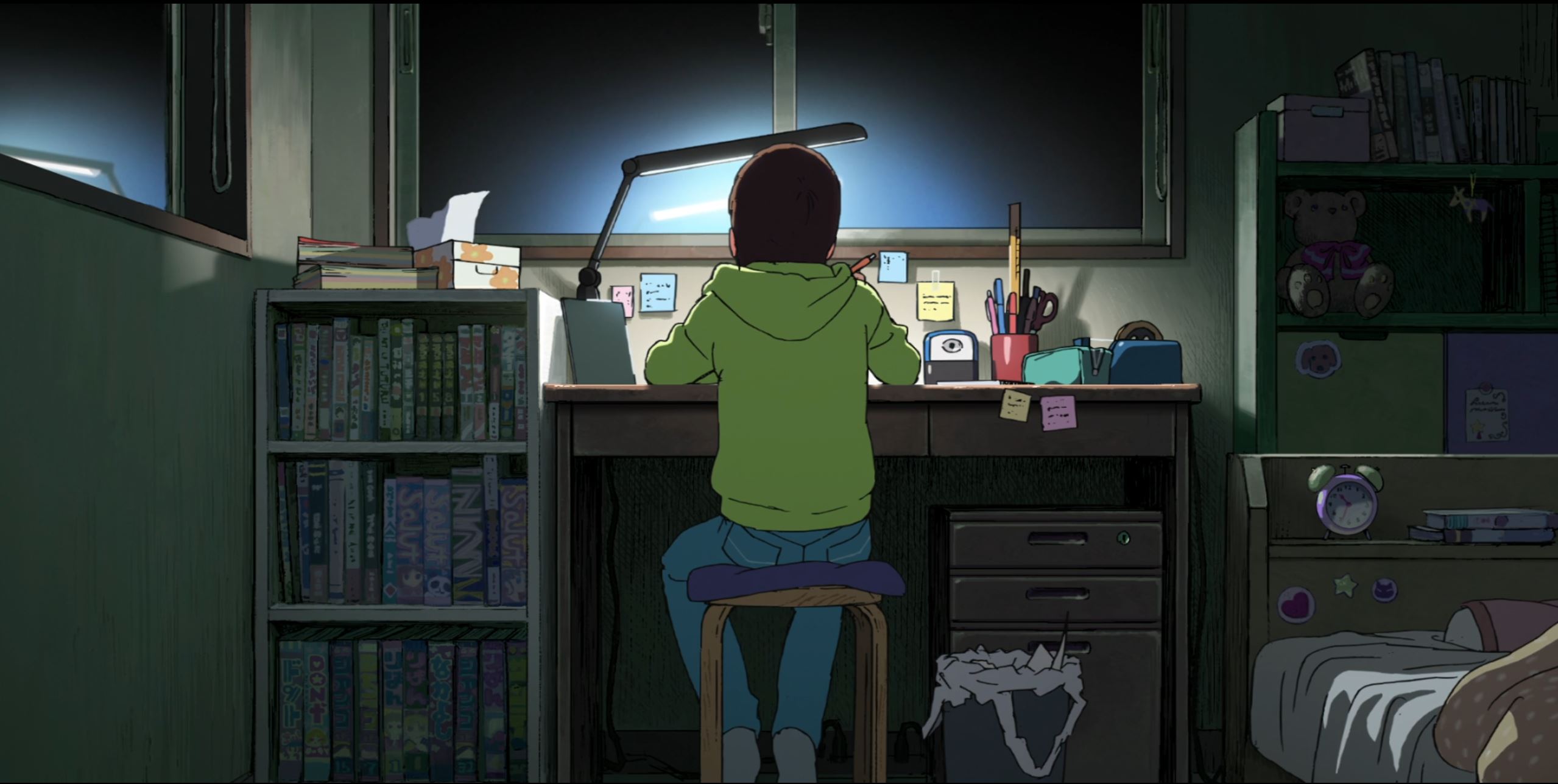
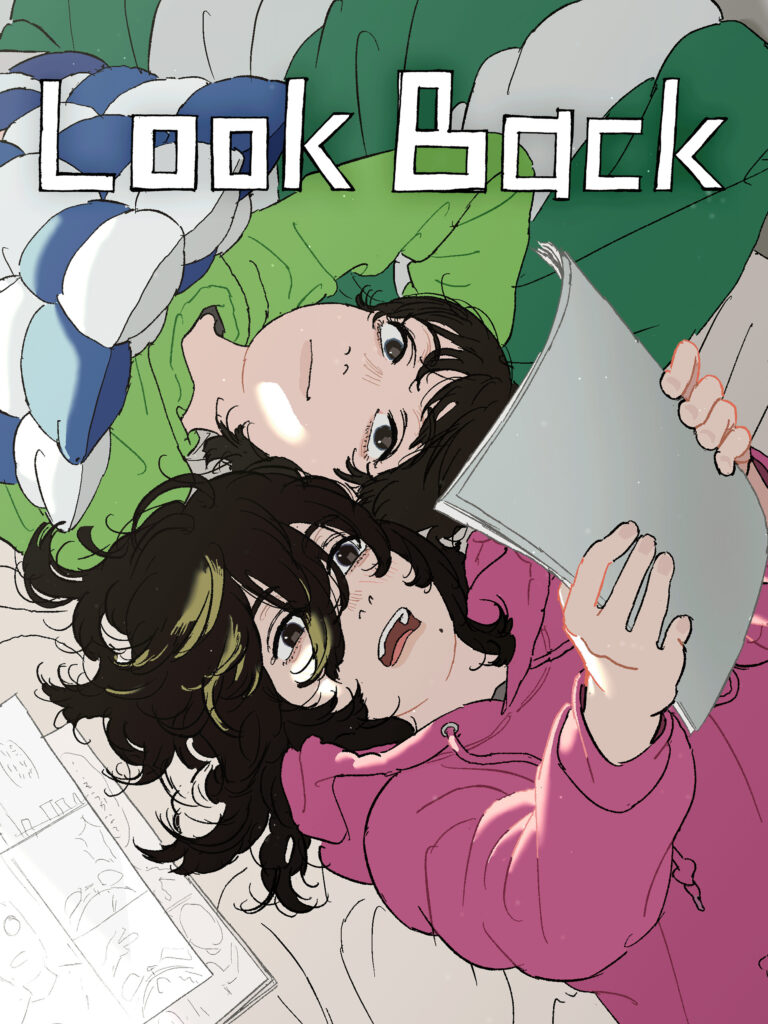
You know that feeling when you’re scrolling through a streaming service, not really sure what you’re in the mood for, and then something just… clicks? That’s what happened with Look Back on Amazon Prime Video. I’d been knee-deep in Apple TV+ content lately, testing out the platform. But after barely making it through a bit of The Instigators—which was, let’s face it, kind of awful, I was done. I needed something different, something that would remind me why I love watching good stories in the first place.
So, I switched over to Prime Video, and there it was: Look Back. The thumbnail caught my eye immediately. It wasn’t flashy—just two kids looking up at a piece of paper—but the colors were so rich and soft, the whole vibe felt nostalgic and creative. I couldn’t quite put my finger on it, but it looked like one of those slice-of-life stories that quietly pulls you in. And, as someone who loves anime, it didn’t take much convincing. The second I saw it, I knew that this was the one.
There wasn’t any flashy marketing or buzz surrounding Look Back—no trailers autoplaying, no giant banners plastered across the screen. It was just quietly sitting there in the Amazon Prime Video catalog, waiting to be noticed. And somehow, it managed to grab me. It wasn’t screaming for attention like so many other titles; instead, it felt almost like a hidden treasure, something you stumble upon and think, this could be special.
What really got me was the thumbnail. It wasn’t some over-the-top anime cover art with glowing swords or impossibly dramatic poses. Instead, it was two kids looking up at a piece of paper, their expressions barely visible, framed by this soft, colorful palette. It gave off this gentle, unassuming energy—like the kind of story that doesn’t demand you to watch it but simply invites you in. It was the kind of image that made me stop scrolling and wonder what was behind it.
That curiosity led me to do a bit of digging. Who was behind this? It turns out, Look Back was produced by Studio Durian—a name I didn’t recognize right away. This was their first major work, but that didn’t mean they were inexperienced. They had previously collaborated with Studio Ghibli on The Boy and the Heron, and that alone was enough to earn my trust. If Miyazaki himself had handed them some of the reins on a project, there had to be something special about their talent.
I couldn’t help but think how bold it was for them to debut with something like Look Back. It wasn’t a sprawling epic or a high-energy action piece. Instead, it seemed deeply personal—a story that required nuance, subtlety, and an eye for detail. For a studio to take on a project like this as their first solo venture?
That’s gutsy. It made me respect them before I’d even seen a single frame of the movie.
Beyond the studio itself, Look Back also came with a stellar reputation. The film had already earned a 100% rating on Rotten Tomatoes and was praised for its unique animation style and emotional depth. That kind of acclaim only heightened my anticipation. This wasn’t just another anime movie tucked away in a streaming catalog—it was being recognized as something exceptional.
By the time I was done looking into it, I wasn’t just intrigued; I was genuinely excited. A debut studio, a perfect Rotten Tomatoes score, and the promise of a deeply emotional story? I was ready to dive in.
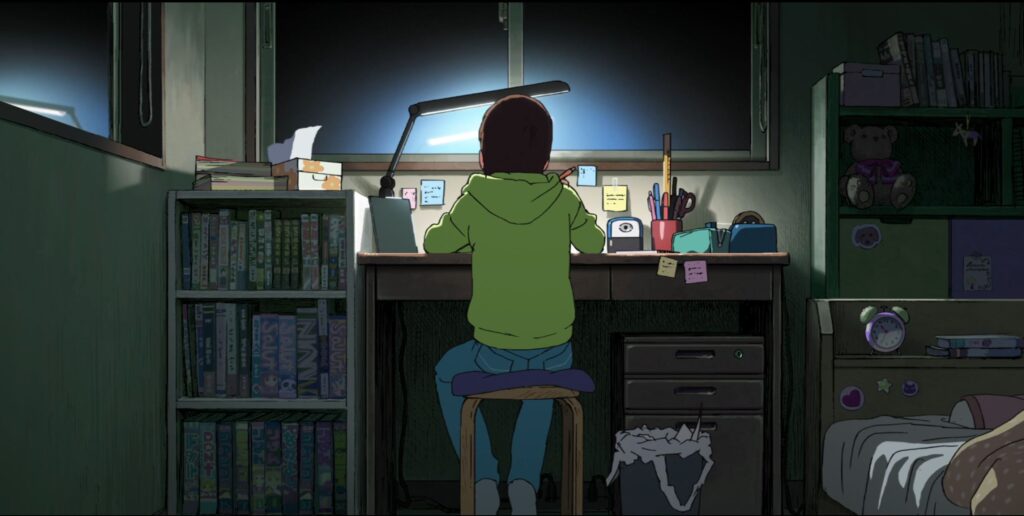
The movie opens with a serene and visually captivating scene: a young girl, later revealed to be Fujino, sitting at her desk, studying. It’s nighttime, and the atmosphere feels quiet and introspective, with peaceful piano music playing in the background. The camera lingers on her from behind, creating a sense of intimacy and drawing you into her small world.
The first thing that struck me was how much this scene reminded me of the lofi girl aesthetic—that iconic YouTube animation of a girl studying with chill music playing. But here, the angle and details set it apart. Instead of the familiar side profile, we see Fujino’s back, framed by her desk and a room filled with warmth and character. It’s as if the animators wanted us to feel like we were peeking into her private, creative space.
The artwork in this scene is breathtaking. The textures are simple yet rich, with soft lines and thoughtfully placed shadows. The lighting feels deliberate, with darkness pooling beneath the desk, contrasting with the warm glow that highlights the bookshelves and bed. Those bookshelves, by the way, are packed with colorful spines of Japanese books, each one popping against the muted tones of the room. The whole space feels vibrant and alive, like it’s brimming with stories waiting to be told.
It’s the details that make this scene extraordinary. Sticky notes are scattered on the walls, books are stacked on the bed and by the window, and her desk is cluttered in a way that feels authentic. You can almost imagine Fujino spending hours here, immersed in her studies—or perhaps something more creative. The balance between minimalism and detail is masterful. It’s not overly busy, but every element is intentional, adding to the sense that this room is an extension of Fujino’s personality.
I had to pause the movie just to absorb the sheer artistry of it. The lighting shifts subtly across the room, adding depth, while the colors—soft yet striking—pull you in. The room feels both real and fantastical, like the kind of space you’d want to step into and explore for yourself.
The scene lingers, allowing you to watch as Fujino stretches, rubs her eyes, and grows visibly tired. You catch a glimpse of the clock: 10:35 PM. It’s late, and she’s clearly been at this for a while. Finally, she rests her head on her desk, and just as the music gently fades, the title card for Look Back appears.
It’s a quiet yet deeply immersive start to the film.
Without any dialogue, it pulls you into Fujino’s world, inviting you to slow down and notice the details. It’s not just a snapshot of a girl at her desk—it’s a window into her life, her space, and perhaps the beginning of something much larger.
As the scene unfolds, we’re led to believe that Fujino is deeply engrossed in her studies, surrounded by books and notes, with the soft glow of her desk lamp adding to the late-night ambiance. But then comes the reveal: she isn’t studying at all—she’s drawing comics. This little twist is both surprising and endearing, adding an immediate layer to her character.
The camera shifts to a top-down view of her desk, and suddenly we’re introduced to her creative world. Sketchbooks, pencils, and even a pencil sharpener are scattered across the desk. It’s such a relatable, messy workspace, full of life and possibilities. The drawing in front of her is a comic titled “First Kiss,” and the panels are filled with the kind of chaotic, over-the-top storytelling only a young mind could dream up.
The story starts off seemingly straightforward but quickly spirals into absurdity.
It’s the kind of imagination that doesn’t care about rules or logic—it’s all about making something exciting and dramatic. It’s charming and a little funny, especially when you realize that this is Fujino’s creative outlet, her way of expressing herself in the quiet moments of her life.
You can almost feel her pride in these drawings, her little escape from the mundane routine of school and studying. It’s a small detail, but it says so much about her as a character—someone who’s already exploring creativity, even in a rough and childlike way.
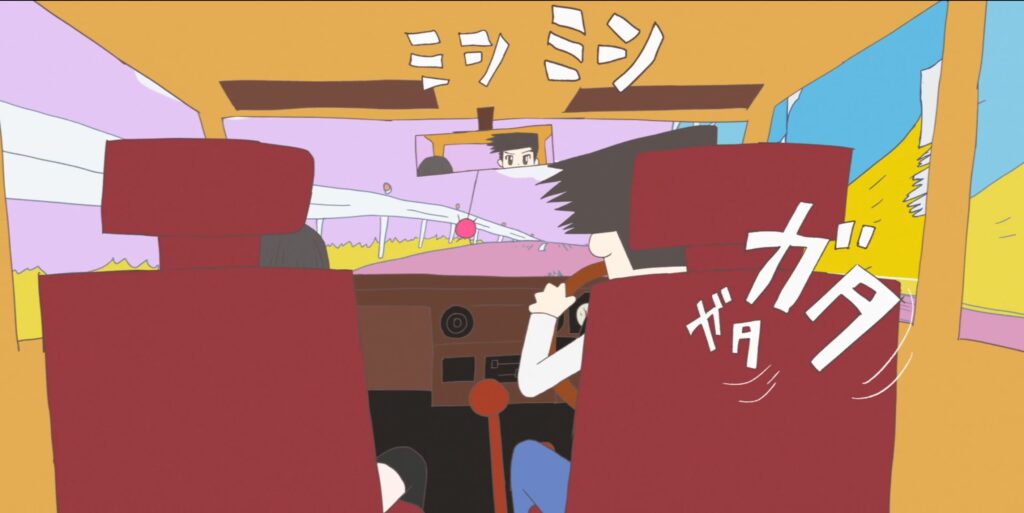
Then comes a magical moment: the camera zooms in on Fujino’s “First Kiss” comic strip, and suddenly, the static panels come to life. The animation shifts to mimic her childlike drawing style, and we’re thrust into the world of her imagination.
The storyline is pure chaos. It starts with a car crash involving a boy and a girl, leading to a bloody, dramatic kiss—hence the comic’s title. But then it takes a bizarre turn. There’s reincarnation, a baby character, and ultimately, a meteor hurtling toward Earth and destroying everything. It’s the kind of wild, no-holds-barred storytelling that only a kid could come up with, driven by pure creativity and zero restraint.
The way the animation mirrors her simplistic, uneven drawing style is brilliant. It’s as if the movie wants us to see the world exactly as Fujino sees it: raw, unpolished, and full of boundless possibilities. The transition from the quiet, reflective study scene to this loud, chaotic animation is jarring in the best way. It’s a moment that reminds you of how wild a child’s imagination can be and how personal and exciting it feels to bring those stories to life.
The next scene shows Fujino’s comic strip featured in the school newspaper, and the response is immediate. Her classmates gather around, reading it and chatting excitedly. It’s clear they’re impressed, and Fujino basks in the attention. You can feel her pride as she sees the smiles and hears the laughter her work has brought.
There’s something so genuine about this moment. It’s not about fame or recognition—it’s about validation. Her creative effort has connected with people, even if just for a fleeting moment. It’s a small triumph, but for a young artist, it means everything
Then comes a bit of tension. A faculty member asks Fujino to deliver her comic strip to a reclusive classmate named Kyomoto. The introduction of Kyomoto adds a layer of intrigue. Who is this person? Why are they so withdrawn? And why is Fujino being singled out to connect with them? It’s the kind of setup that hints at a deeper relationship to come, even though Fujino doesn’t seem thrilled about the task.
When the next school newspaper is released, everything changes. Fujino eagerly grabs a copy, but instead of basking in more praise, she’s confronted with something unexpected: a comic strip by Kyomoto.
The contrast between the two strips is striking. Where Fujino’s work is colorful, fun, and chaotic, Kyomoto’s strip is eerie, detailed, and deeply atmospheric. The panels depict a stairwell, a classroom, and a schoolyard, but there’s an unsettling realism to them that immediately sets Kyomoto apart.
Fujino’s reaction is raw and relatable. As her classmates whisper about how incredible Kyomoto’s work is, she begins to feel the weight of inadequacy. The praise she had just enjoyed now feels hollow in comparison to the awe Kyomoto is receiving. It’s a tough moment, but it’s also the kind of moment that every creative person has faced—the realization that someone else might be better at the thing you love.
Kyomoto’s talent shakes Fujino, but it also sparks something in her.
You can see her wrestling with a mix of jealousy, admiration, and self-doubt, and it sets the stage for what’s to come. This is no longer just a slice-of-life story; it’s shaping into a tale about creativity, competition, and how we grow through the people who challenge us.
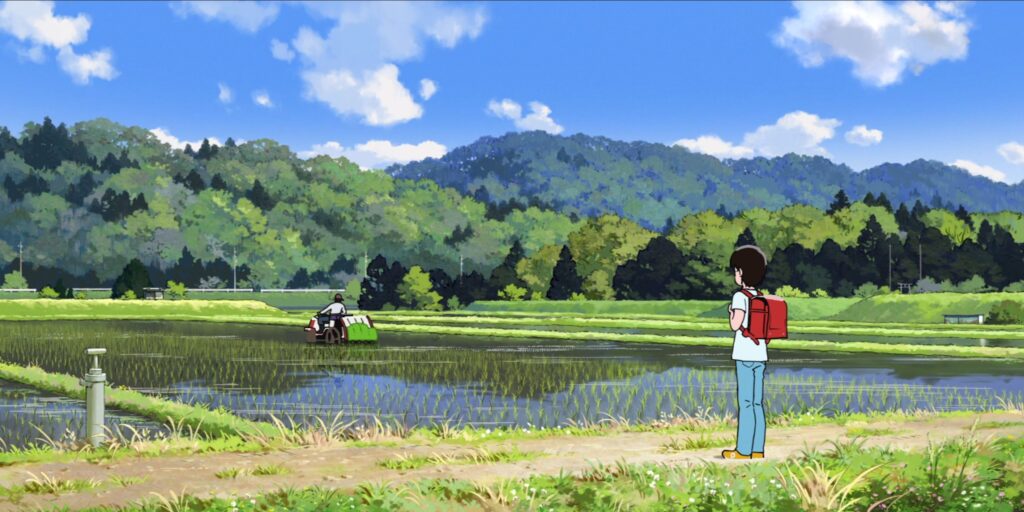
As Fujino walks home after seeing Kyomoto’s comic strip, the scene shifts to a stunning depiction of rural Japan, and it feels like the movie takes a moment to breathe. The lush green foliage, vibrant rice fields, and endless blue sky are jaw-droppingly beautiful. It’s one of those moments where you want to pause and just soak in the artistry, which is exactly what I did.
The colors in this scene are incredibly vivid. The greens of the rice fields feel alive, almost glowing with saturation, while the sky above stretches endlessly in a gradient of soft blues and whites. The clouds are fluffy and detailed, creating a perfect contrast to the rich greens below. Every element is saturated with life and detail, making it impossible not to feel immersed in this serene, picturesque setting.
Fujino herself seems lost in thought, and it’s easy to imagine why. The beauty of the landscape around her mirrors the kind of quiet reflection she’s likely experiencing. She’s processing what just happened—the blow of seeing Kyomoto’s talent and the whispers of comparison from her classmates—and this calm walk home feels like the perfect moment for her to sort through her emotions.
What really stands out in this scene is how the environment seems to tell its own story. The rural setting, with its tractors in the distance and the symmetry of the rice paddies, creates a sense of groundedness. It’s the kind of imagery that feels deeply tied to the cultural identity of Japan, a reminder of simpler, slower-paced moments. It’s also a contrast to the emotional chaos Fujino might be feeling inside.
This scene reminded me why I love slice-of-life anime. Even without dialogue, you can feel so much. It’s not just about the characters or the plot—it’s about the way the art captures a mood, a sense of place, and an emotional undercurrent. As Fujino walks through this lush environment, it’s like the movie is asking us to slow down too, to notice the little details and let the scenery sink in.
By the time the scene ended, I wasn’t just watching anymore; I felt like I was walking alongside Fujino, absorbing the beauty around us and thinking about her journey so far. It’s one of those moments that stays with you long after the movie moves on.
After her humbling experience with Kyomoto’s comic strip, something shifts in Fujino. Instead of letting the moment crush her, she channels her feelings into determination. She’s not ready to give up. The next thing we see is Fujino sitting in front of a computer, researching how to improve her drawing skills. It’s such a relatable moment—who hasn’t gone down the rabbit hole of “how-to” searches after deciding to take on a new challenge?
Fujino’s resolve is inspiring, and the movie does a great job of showing her next steps. She heads to a bookstore, carefully selecting drawing materials and books on anatomy and techniques. There’s something quietly exciting about watching her pick out supplies, like she’s equipping herself for a creative battle.
When she gets home, the real work begins. Fujino sets up her materials and starts practicing. At first, it’s basic stuff—anatomy sketches, line work—but you can already feel her focus. Her earlier pride in her comic strip has turned into a hunger to grow, to become better. Watching her dive into this process is incredibly relatable and motivating, especially for anyone who’s ever wanted to improve their craft.
The scene feels like the calm before the storm, setting the stage for what comes next. It’s not just about her frustration or determination—it’s about the quiet beauty of taking that first step toward something bigger.
And then, the montage begins. It’s a visual and emotional feast, showing Fujino’s relentless practice as time passes. She draws and draws, filling notebook after notebook with sketches, studies, and ideas. The movie doesn’t just show her practicing; it shows her world changing with each stroke of the pencil.
What makes this sequence so powerful is how it’s tied to the seasons. You see Fujino’s growth mirrored in the passing of time—summer’s bright greens, autumn’s warm oranges, winter’s stark whites, and spring’s hopeful blooms. Each season brings its own atmosphere, and through it all, Fujino keeps drawing, her determination unwavering.
The music in this montage is particularly striking. It’s uplifting and inspiring, carrying you along with Fujino’s journey. The rhythm of the score feels like it’s synced to her progress, rising and falling as her skills improve. You can’t help but feel a sense of awe as you watch her go from messy sketches to more refined, thoughtful work.
The montage also does a fantastic job of showing the toll and reward of dedication. There’s no dialogue, just visuals of Fujino hunched over her desk, flipping through books, practicing anatomy, and experimenting with techniques. You can see her collecting more art supplies, expanding her library of drawing references, and filling up stacks of notebooks.
And yet, the beauty of the world around her doesn’t go unnoticed. There’s a particularly stunning shot of a mountain framed by lush green rice paddies, set against a clear blue sky. It’s a reminder of the balance between Fujino’s internal growth and the external beauty of her environment.
By the end of the montage, Fujino’s room is transformed. The once-quiet space is now brimming with her efforts—papers, books, sketches, and a sense of accomplishment. It’s a triumphant sequence that captures not just the work of improving, but the joy of falling in love with the process. It’s inspiring and a little humbling, a reminder of what passion and dedication can achieve.
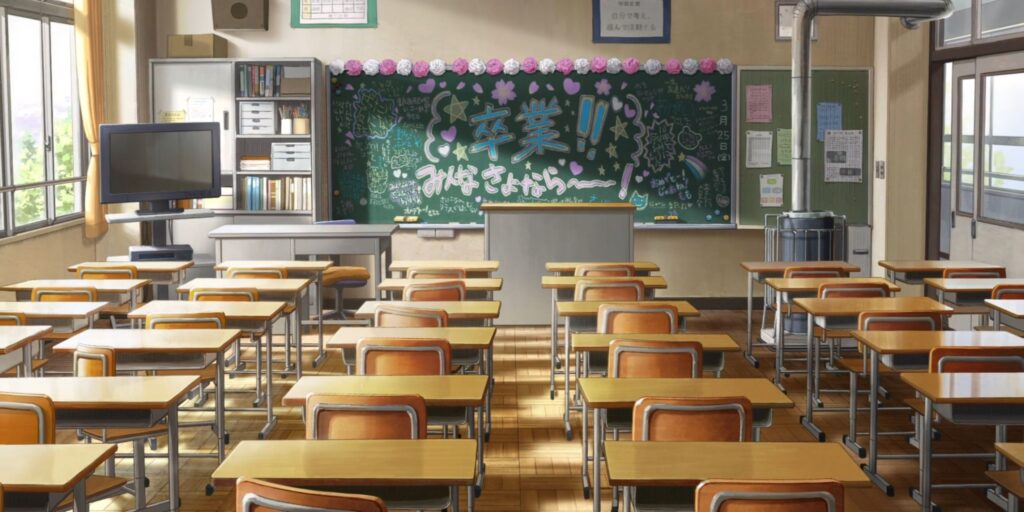
As the montage of changing seasons wraps up, we shift to a quieter, more reflective moment—graduation day. After all the energy of Fujino’s drawing journey, this scene hits differently. It’s like hitting pause after a whirlwind, stepping into a space that feels frozen in time, full of memories and meaning.
The classroom, where so much of Fujino’s story has unfolded, now feels different—special. It’s not just a regular setting anymore. You can feel the weight of everything that’s happened there, like the room itself is holding onto all her struggles, triumphs, and moments of growth. It’s a mix of nostalgia and pride, and it really sets the tone for this big moment in her life.
What makes this scene so powerful is how it invites the viewer to pause and absorb the details. From the colorful flowers adorning the chalkboard to the vibrant writing celebrating the graduation, every element feels carefully placed to evoke a sense of pride and accomplishment. It’s a moment that blends the personal and the universal, giving us a window into both Fujino’s world and the universal milestone of growing up.
The first thing that grabs your attention is the classroom itself—it’s practically glowing with personality. The chalkboard is adorned with colorful Japanese writing, celebratory messages, and carefully drawn flowers that make the scene feel alive. You can tell that the students and teachers put effort into decorating the room, giving it a festive atmosphere that feels deeply personal.
The details in this scene are astounding. The room is bathed in natural light, streaming in from large windows that give you a glimpse of the outside world—a reminder that this moment is both an ending and a beginning. On the desks, you can spot little touches like notebooks, pens, and scattered items, all adding to the authenticity of the setting. It’s not just a generic classroom—it’s Fujino’s classroom, brimming with memories and meaning.
What really struck me, though, was the chalkboard. It wasn’t just a board—it was a canvas, full of colorful messages and illustrations that seemed to celebrate not only the day but the personalities of the students themselves. The vibrant flowers and bold kanji writing stood out against the dark green surface, creating a contrast that was visually striking and emotionally resonant.
This scene took me back to my own visit to Japan in early 2020, right before the pandemic turned the world upside down. Being there, I was struck by how much thought and care goes into even the smallest details of everyday life. Watching this scene brought that feeling rushing back.
It’s one of the reasons I love slice-of-life anime so much—it captures the essence of Japan in a way that feels authentic and heartfelt. Even if you’ve never been there, a scene like this gives you a sense of what it might be like to stand in a classroom like this, to feel the weight of the moment, and to see the beauty in its simplicity.
The animation style in this scene is worth noting too. It strikes a delicate balance between subtle textures and vibrant colors. The walls and floors are rendered in soft, muted tones that give the space a lived-in feel, while the decorations and sunlight bring bursts of life and energy. It’s a mix of the detailed and the minimal, creating a scene that feels both real and slightly idealized—like a memory brought to life.
What’s most impressive is how the filmmakers managed to evoke so much emotion without heavy dialogue or action. The quiet stillness of the empty classroom, paired with the colorful decorations, feels almost meditative. It’s a reminder of the passage of time, of milestones, and of the inevitable changes that come with growing up.
As Fujino walks through the classroom, you can sense a mix of emotions—pride, nostalgia, and maybe a touch of sadness. The scene feels like a love letter to those fleeting, unforgettable moments in life when you’re on the cusp of something new but can’t help looking back at what you’re leaving behind.
This wasn’t just a scene—it was a memory captured on film. And it’s moments like these that remind you why Look Back is such a treasure. It’s not just about the story; it’s about the emotions, the details, and the way it invites you to pause and reflect on your own life.
After graduation, Fujino is given a task she doesn’t particularly want—delivering Kyomoto’s diploma. She’s called into the faculty room, which is yet another scene brimming with detail. The office is cluttered with colorful paper folders, scattered pens, rulers, and even pieces of clothing hanging on chairs. It’s the kind of organized chaos that feels incredibly real, as though you could step into the room and shuffle through the papers yourself.
Fujino’s reluctance is palpable as she listens to the faculty member explain the task. She’s clearly uncomfortable, but she accepts, setting out on a journey that feels less like an errand and more like the beginning of something significant.
When she arrives at Kyomoto’s house, it’s quiet and seemingly empty. The door is slightly ajar, and Fujino hesitates before stepping inside. The house feels eerie, with dim lighting and an overwhelming stillness that contrasts sharply with the vibrant, bustling school scenes earlier. It’s here that the story begins to shift—what starts as a simple task becomes a pivotal moment in Fujino’s journey.
As Fujino explores Kyomoto’s house, she stumbles upon what can only be described as an artist’s sanctuary. Kyomoto’s room is filled with hundreds of notebooks, stacked and scattered in a way that speaks volumes about her dedication to her craft. The sheer number of sketchbooks and comic strips is both overwhelming and inspiring, a testament to the kind of quiet, obsessive passion that can go unnoticed by the outside world.
Fujino picks up a blank comic strip and, in a spontaneous moment, draws a humorous sketch of Kyomoto, imagining her as a skeleton surrounded by people cheering for her to come outside. It’s lighthearted and a little cheeky, showing Fujino’s playful side. But then something unexpected happens—the drawing slips under Kyomoto’s door.
The tension rises as Fujino hears Kyomoto pick up the strip. Embarrassed and unsure of what to do, she bolts from the house, only to be stopped when Kyomoto herself comes running after her. It’s an emotional and almost surreal moment, as these two characters finally come face to face.
The interaction between Fujino and Kyomoto is nothing short of transformative. Kyomoto, who has been watching Fujino from afar, reveals that she’s been a fan of her work since the third grade. The revelation is shocking for Fujino, who has spent so much time feeling overshadowed by Kyomoto’s talent. To hear that admiration has been mutual all along flips her perspective completely.
Kyomoto’s words are heartfelt and genuine. She calls Fujino a genius and expresses how much she’s looked up to her. It’s a moment of connection that feels raw and honest, as both characters lay their insecurities bare. For Fujino, this is a turning point. The jealousy and self-doubt that have plagued her start to melt away, replaced by a renewed sense of purpose and excitement.
As Fujino walks home, the rain begins to fall, but it doesn’t dampen her spirits. If anything, it adds to the moment’s emotional weight. She skips and runs through the rain, her heart lighter than it’s been in a long time. The scene is beautifully animated, with muted grays and beiges creating a soft, reflective atmosphere. It’s a visual and emotional release, perfectly capturing the joy of newfound inspiration and understanding.
This sequence of events—delivering the diploma, discovering Kyomoto’s world, and their heartfelt meeting—feels like the emotional core of Look Back. It’s where the characters truly come alive, and the story begins to transcend its simple premise, becoming a meditation on creativity, connection, and the power of shared passion.
Fujino’s journey home after meeting Kyomoto feels like pure happiness. You can see her excitement in every step as she skips and runs along the rural paths, completely alive with a new energy. It’s raining, but the scene doesn’t feel gloomy at all. Instead, it feels refreshing and full of life.
The animators capture the beauty of the rain-soaked landscape in a way that feels real and almost magical. The rice paddies stretch out on either side of the path, their greens muted just slightly by the soft rain. Puddles on the ground reflect the cloudy sky, adding a shimmering effect that makes the scene feel layered and alive. Raindrops fall gently, blending with a soft background score that highlights Fujino’s newfound joy.
This walk home isn’t just a normal walk—it’s a release of all the doubt and frustration Fujino had been carrying. Learning that Kyomoto admired her all along has completely lifted her spirits, and it shows. Her movements are light and carefree, as if all her worries have been washed away by the rain. The muted tones of the sky and earth make Fujino stand out even more, with her energy and emotions becoming the center of attention.
By the time she gets home, drenched but smiling, you can feel her renewed sense of purpose. It’s one of those scenes that perfectly blends the beauty of nature with the emotions of the character. You’re left with a sense of calm and optimism, as if you’ve gone on that walk with her and felt the same transformation.
The montage that follows shows Fujino and Kyomoto working together on their manga project, and it’s packed with energy and warmth. It’s a joy to watch these two characters, so different in personality, find a rhythm as they create something together.
The room where they work quickly becomes a creative hub, alive with activity. Sketches, notes, and supplies are everywhere, and string lines stretch across the space, holding up finished manga pages like trophies of their hard work. Their personal spaces, once neat and reserved, are now brimming with the mess of creativity—a sign of how much they’re putting into their collaboration.
What makes this montage so heartwarming is how it shows the connection between Fujino and Kyomoto. Kyomoto, who once stayed hidden, starts to open up, quietly enjoying the process. Fujino, full of energy and confidence, leads the charge, but there’s a clear respect between them. They’re not just working on a manga; they’re building a friendship with every page they create.
The music during the montage is light and cheerful, matching the excitement of their growing bond. You see time pass through small details—the sunlight shifting through the windows, their workspace getting messier, and more finished pages hanging up. It’s like you’re watching their passion and teamwork grow right in front of you.
By the end of the montage, you can’t help but feel connected to their journey. It’s not just about creating a great manga—it’s about finding someone who gets you, who shares your dreams, and who makes the hard work feel meaningful. This part of the movie is a celebration of teamwork, friendship, and the simple joy of doing what you love with someone who truly understands.
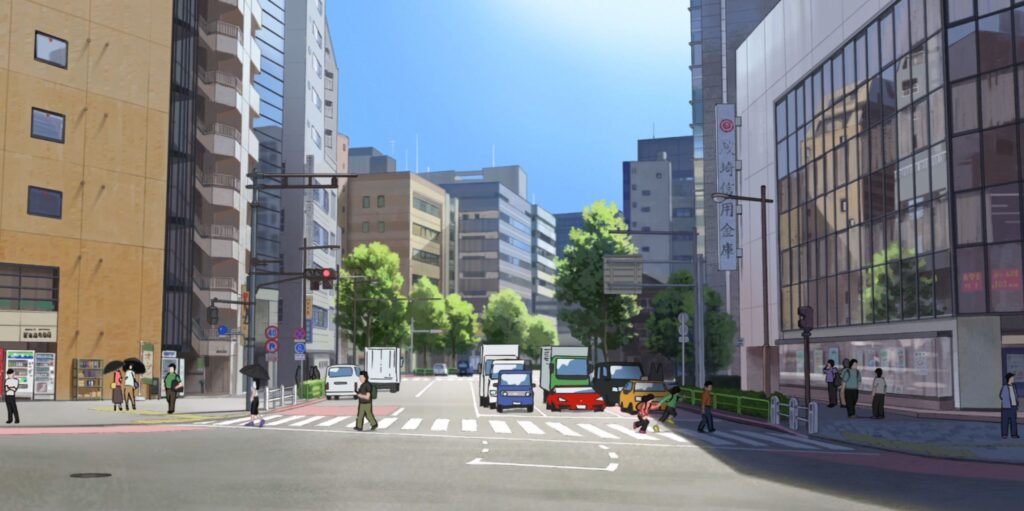
As the montage of Fujino and Kyomoto’s adventures winds down, the scene transitions to a bustling city street, bringing a shift in energy and tone. The quiet focus of their collaboration gives way to the vibrant hum of urban life. This moment feels like a natural progression, as if the world is expanding alongside their dreams, pulling them from the small, intimate spaces of their youth into the sprawling opportunities of the city.
It’s here that the movie slows down, inviting us to take in the sheer beauty of the environment. Every detail in this cityscape feels alive, from the reflections in the windows to the textured facades of the buildings. It’s not just a background—it’s a character in itself, full of depth and personality, perfectly capturing the balance between the overwhelming scale of the city and the small, relatable human stories unfolding within it.
The first thing that stands out is the contrast between the foreground and background. The objects closest to you—the cars, the pedestrians, the streetlights—are drawn in a cell-shaded style that gives them a slightly animated, almost puppet-show quality. Behind them, the buildings and skyline are incredibly detailed, creating a depth that feels real and immersive. It’s as if the scene is layered, with each part carefully placed to guide your eyes across the frame.
The reflections in this scene are breathtaking. One building on the right, with large glass windows, perfectly mirrors the building across the street. It’s not just a flat reflection, either—you can see the distortion and slight imperfections in the glass, making it feel like something you’d notice if you were walking through an actual city.
The lighting adds even more to this. Some buildings are in full sunlight, glowing with warm tones, while others are in shadow, creating a mix of light and dark that feels natural and dynamic. One of my favorite details is the green trees scattered among the buildings. They pop against the gray tones of the city, giving the scene a splash of life. The trees aren’t overly detailed, but the shades of green vary enough to feel rich and realistic. It’s a reminder that even in the middle of a bustling city, nature finds its place.
Then there are the smaller details—the vending machines on the left side of the street, the stairs spiraling up the side of a building, and the faint outlines of street signs and advertisements. Nothing is left out, but nothing feels overcrowded either. It’s balanced in a way that feels effortless, even though you know a ton of thought went into every element.
The movement in this scene is subtle but effective. Cars drive by, pedestrians walk across the street, and the wind seems to ripple through the trees and flags hanging on some of the buildings. It’s not overly busy, but there’s just enough motion to make the scene feel alive.
What really gets me about this scene is how it feels like you could step right into it. You can almost hear the faint sounds of city life—the hum of cars, the murmur of people talking, maybe even the distant beep of a crosswalk signal. It’s so immersive that it’s easy to forget you’re watching an animated movie.
As Fujino and Kyomoto run across the street, the focus shifts back to them, but the city remains an integral part of the frame. The characters feel like they belong in this world, and the scene seamlessly blends their movement with the backdrop, creating a moment that’s as much about the environment as it is about their journey.
This city street scene is a perfect example of the artistry in Look Back. It’s not just about the story—it’s about creating a world that feels lived-in, real, and utterly captivating. Every frame is packed with detail, but it never feels overwhelming. Instead, it invites you to slow down and take it all in, like a stroll through a city you’ve never been to but already love.
Fujino and Kyomoto’s meeting with the publisher is a pivotal moment, marking the first time their hard work is professionally recognized. The publisher is visibly impressed, marveling at the quality of their manga, especially considering their age. His comment that, “at worst, it might get an honorable mention,” is understated praise that clearly excites the girls.
The office setting, with its clean lines and subtle lighting, contrasts with the colorful, cluttered spaces of their creative process. Yet even here, the scene is rich with detail—light streaming through windows and reflections on polished surfaces keep the environment grounded and relatable.
This meeting is more than validation; it’s a turning point. For Kyomoto, it’s a moment of stepping into the world she’s been afraid to face, while Fujino’s growing confidence finds new purpose. Both are filled with pride and anticipation, fueled by the realization that their dream is becoming tangible.
As the scene ends, the sense of possibility is undeniable. This is the beginning of something bigger, and you can’t help but feel the same excitement they do. Their journey so far has been inspiring, and this moment feels like a well-earned reward.
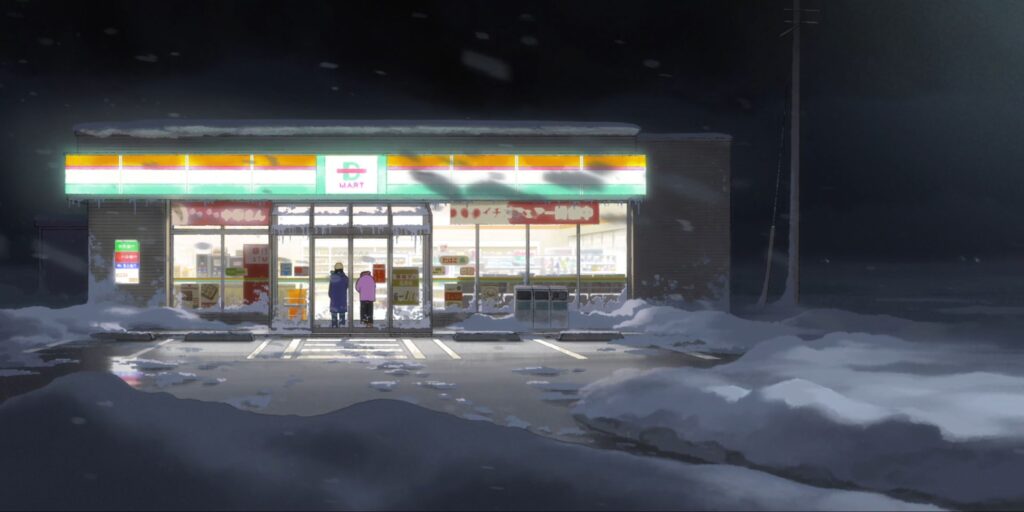
After the high-energy meeting at the publisher, where Fujino and Kyomoto’s hard work earned well-deserved recognition, the scene shifts to something quieter. We follow them as they walk through the snow, the world around them cold and muted. The crunch of their footsteps and the swirling wind create a stark contrast to the buzz of the publisher’s office. The journey feels reflective, as if the weight of their achievement is settling in with every step.
Then, through the snowy haze, the convenience store comes into view, glowing warmly against the dark, icy backdrop. It feels like a reward for their perseverance—a small beacon of light in an otherwise harsh and unforgiving landscape. The shift from the chilly, empty streets to the vibrant glow of the store is visually stunning, drawing you into the scene with its quiet yet powerful contrast.
Out of all the visually stunning moments in Look Back, the scene where Fujino and Kyomoto traverse the snowstorm and arrive at the convenience store stands out as my absolute favorite. This sequence feels like a perfectly crafted painting that you could frame and hang on your wall—each frame bursting with atmosphere, detail, and emotion.
It begins with the two of them walking through a blizzard. The snow falls heavily against a dark backdrop, the wind howling faintly in the distance. The blizzard feels tangible, almost cold to the touch, with the flakes swirling in chaotic patterns as they trudge through the night. The muted tones of white and gray dominate the scene, giving a sense of isolation and determination as the girls push forward.
Then comes the transition to the convenience store, and this is where the magic truly happens. The store glows like a beacon against the pitch-black night, its lights diffused through the foggy, moisture-filled air. The glow is soft yet vibrant, with the signature green, white, and orange stripes of the building’s exterior popping brightly against the muted blues and blacks of the surroundings.
The level of detail here is astounding. The parking lot reflects the glowing lights in shimmering puddles, creating a mirror-like surface that adds depth and realism. On the left, a brightly lit sign casts a soft reflection on the ground, while the right side of the frame is balanced with a streetlamp diffusing more light into the scene. The textures of the wet ground, the crisp snow lining the edges, and even the faint smudges of condensation on the store’s windows make you feel like you could step right into the moment.
Inside the store, the scene is just as impressive. The shelves are meticulously stocked with colorful packages and neatly arranged products. The lighting feels warm and inviting, contrasting with the cold, harsh blizzard outside. If you look closely, you can see small details like faint price tags, bold Japanese typography on packaging, and even the slight blur of objects in the foreground to mimic a camera’s depth of field. It’s these tiny touches that elevate the scene, making it feel alive and authentic.
This convenience store shot is more than just a background—it’s a mood. It captures a perfect balance between the cold, harsh reality of the blizzard and the warm, comforting glow of a safe haven. The artistry on display is jaw-dropping, and every time I revisit this scene, I find something new to appreciate. It’s easily my favorite visual moment in the entire movie, and a testament to the level of care and talent poured into Look Back.
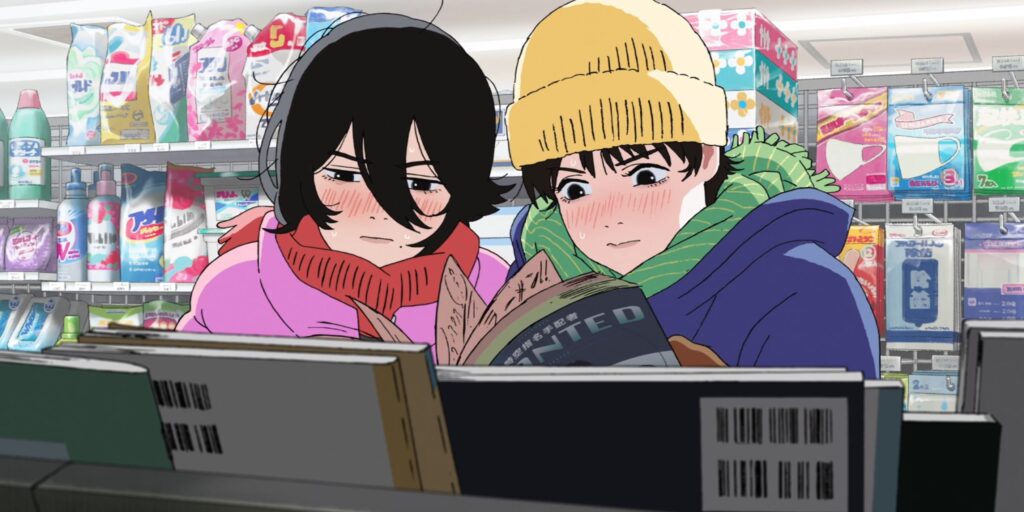
Once inside the convenience store, Look Back elevates its visual artistry to new heights. It’s not just a store—it’s a stunningly detailed and immersive environment that feels alive with texture and color, as if you’re walking through it alongside Fujino and Kyomoto.
The first thing that stands out is the vibrant product displays. Every shelf is carefully arranged, bursting with color and variety. The top shelves are lined with brightly colored bags, likely snacks or candies, their whimsical designs adding a playful energy to the scene. Below them, neatly organized bottles catch the eye with faintly discernible labels, a testament to the meticulous care poured into every detail. Even the lower shelves stocked with household items are rendered with precision, each package showing subtle gradients and realistic textures.
The lighting inside the store adds to its charm, glowing warmly and offering a stark contrast to the cold blizzard outside. The fluorescent lights cast an even brightness across the space, illuminating the shelves and creating subtle reflections on the polished floor. This lighting brings a sense of life and warmth to the store, making it feel like a cozy refuge from the harsh elements.
What really sets this scene apart is the animation’s use of depth and focus. The shelves and items closest to the foreground are slightly blurred, directing attention to Fujino and Kyomoto as they browse the manga section. This effect mimics the focus of a camera lens and lends a cinematic quality to the scene. The ceiling lights, with their artificial glow, bounce light off the shelves and create a natural texture that makes the space feel tangible.
As Fujino and Kyomoto explore the aisles, the attention to detail remains impeccable. The manga section itself is a standout, with rows of neatly stacked books featuring realistic spines and covers. The designs feel authentic enough that you can imagine reaching out to grab one and flip through it. These little touches ground the scene in reality and add to the overall immersion.
This moment inside the convenience store is more than just a visual treat—it’s a reflection of the film’s ability to find beauty in the everyday. It transforms a mundane setting into a memorable, almost magical space, capturing a sense of warmth and connection that mirrors the themes of the story. It’s a scene you’ll want to revisit, not just for its emotional resonance but for the sheer artistry it showcases.
The moment Fujino and Kyomoto discover they’ve won runner-up in the manga contest is pure joy. It’s the culmination of their hard work, countless hours, and late nights—a validation of their talent and dedication. The results are simple: their manga, Metal Parade, earned a runner-up prize. For two middle schoolers, it’s a massive achievement.
Fujino’s excitement is instant, her face lighting up with pride and relief. Kyomoto’s reaction is quieter, a soft smile that reflects the significance of the moment for her. For someone who’s spent so much time withdrawn, this recognition feels transformative, affirming her place in the world beyond her isolated routine.
As they celebrate, the movie shifts to an exterior shot of the convenience store. The warm glow of its lights contrasts beautifully with the dark night outside, perfectly mirroring the girls’ happiness. It’s not a grand celebration, but it doesn’t need to be—the simplicity of their joy is what makes it so relatable.
This victory isn’t just about the contest; it’s about what it symbolizes. It marks the beginning of something bigger, a new chapter in their journey. The scene’s understated charm, with its quiet celebration and genuine emotion, leaves a lasting impression. It’s a heartwarming reminder of the rewards of perseverance and the power of collaboration.
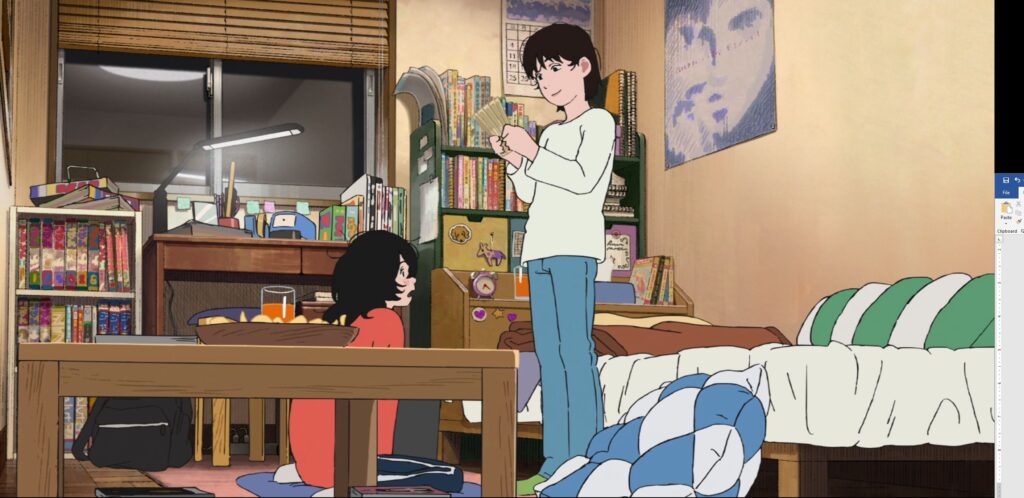
After the quiet yet joyful celebration of their manga contest win at the convenience store, the scene transitions to Fujino’s bedroom—a space that feels like the heart of her creativity. The shift is seamless, taking us from the shared triumph of the contest to a more personal, intimate moment in the place where her artistic journey truly began.
It’s as if the film is reminding us that behind every success lies the countless hours spent in solitude, honing a craft. Fujino’s bedroom, alive with color and detail, reflects the vibrant energy of her creative spirit and provides a warm, comforting contrast to the cold night outside.
The first thing you notice is the rich color palette. The warm yellows and oranges from the lighting give the room a lived-in, comforting glow. The artificial light casts subtle shadows that play off the various objects in her space, creating depth and a sense of movement. The tones of her surroundings—muted reds, earthy greens, and deep blues—are balanced perfectly, making the room feel vibrant without being overwhelming. It’s the kind of place that feels both inviting and inspiring, as though creativity itself lives in the walls.
Above her bed, there’s a shelf packed with books, their spines forming a rainbow of colors that immediately catches the eye. Each book has its own distinct hue and texture, and the detail here is stunning. Some covers appear smooth, while others have a more weathered, watercolor-like texture that adds a layer of realism.
This corner of the room feels like a direct nod to Studio Ghibli’s style—where everyday objects are elevated into something extraordinary through meticulous attention to detail.
Scattered around the room are hints of Fujino’s creative process. On her desk, there’s a cup overflowing with pens and pencils, drawing pads stacked neatly, and erasers and tape dispensers placed within easy reach. The organized chaos of her tools speaks volumes about her dedication and the hours she’s spent here. The glow of her desk lamp highlights these items, making them feel almost like artifacts of her artistic journey.
What really stands out is the subtle interplay of light and shadow. The warm lighting creates soft highlights on the books and objects, while the corners of the room remain dim, giving the space a sense of depth. The shadows under her bed and behind her bookshelves are understated but effective, adding to the room’s natural and immersive feel. It’s as if the animators wanted to ensure that every square inch of this scene told a story.
The textures in the room further amplify its charm. The wooden furniture has a soft grain visible even under the warm lighting, while the paper on her walls and desk has a tactile quality, almost inviting you to reach out and touch it. Sticky notes with scribbled drawings and reminders are pinned to the walls, adding a personal touch that grounds the scene in the everyday life of a young artist.
This isn’t just a bedroom; it’s a sanctuary of creativity. You can feel how much time Fujino has spent here, pouring her heart into her work. The careful arrangement of objects, the interplay of colors, and the cozy lighting make this space not just a background but a character in its own right. It reflects Fujino’s inner world—her determination, imagination, and passion.
By setting this scene at night, the filmmakers emphasize the quiet intensity of Fujino’s dedication. The world outside is dark and still, but her room is alive with warmth and color, mirroring the fire of her creative ambition. It’s a space that feels magical yet grounded, and every detail adds to the immersive experience. This is a scene you could pause endlessly, always finding something new to appreciate.
With their manga gaining recognition, Fujino and Kyomoto take a well-deserved break, exploring the city together. These scenes are brimming with vibrant, fleeting moments—browsing books, eating at lively burger joints, and soaking in the energy of a bustling urban world.
The city feels almost magical, with its bright lights and endless possibilities, providing the perfect backdrop to their growing friendship. It’s a reminder of the joy in small, everyday adventures, evoking a sense of wonder reminiscent of Spirited Away.
What makes these moments so memorable is how the city becomes an extension of their bond. The wide streets and glittering storefronts seem to mirror their expanding world, full of untapped potential and discovery. The detail in the animation—the crisp shadows, subtle reflections in the windows, and lively street scenes—adds a layer of depth to their journey. It’s not just a setting; it’s a vibrant character in its own right, alive with promise and opportunity.
Amid their explorations, a quieter moment surfaces when the two discuss their futures. The carefree energy of the city gives way to a more reflective tone as Kyomoto reveals her decision to attend art school, while Fujino doubles down on her commitment to manga.
Their conversation is filled with excitement but also a subtle tension, as they realize their paths may soon diverge. The contrast between Kyomoto’s structured ambition and Fujino’s unshakable passion for manga underscores the unique paths they’re carving for themselves.
This scene feels deeply personal, capturing the bittersweet nature of growing up. Kyomoto’s aspirations hint at her desire for stability and artistic growth, while Fujino’s determination to pursue manga speaks to her love for storytelling and her growing confidence. The simple act of sharing these dreams emphasizes their mutual support, even as their choices lead them in different directions. It’s a quiet yet powerful moment that reflects the complexities of friendship and ambition.
Their conversation about the future transitions naturally into a montage of Fujino’s relentless dedication. We watch as she pours herself into her work, producing volume after volume and eventually seeing her manga adapted into an anime. The sequence captures her determination and growth, showcasing the rewards of her hard work while hinting at the emotional toll it’s taking. This glimpse into her rising success feels both triumphant and reflective, as though it’s setting the stage for the challenges yet to come.
The montage artfully combines progress and exhaustion, with scenes of late-night sketching, coffee cups piling up, and animated panels coming to life. Each frame conveys the immense effort behind her success, reminding us that every achievement comes with sacrifice. The music swells, adding an emotional weight to her journey, as we see Fujino’s passion evolve into a profession. It’s an inspiring yet sobering depiction of the cost of chasing one’s dreams.
The triumph of Fujino’s success is abruptly shattered when she learns of the school attack. The joyful rhythm of the montage slows to a devastating halt as the weight of the news sinks in. The implications for Kyomoto are immediately clear, and the stark shift in tone leaves an unsettling silence. This moment draws a sharp contrast to the progress and celebration that came before, emphasizing the fragility of the relationships and lives that Fujino holds dear.
The scene is hauntingly effective, with muted tones and fragmented news clips that slowly reveal the gravity of the situation. Fujino’s growing panic is palpable as she desperately tries to reach Kyomoto, her fears escalating with each unanswered call. It’s a chilling reminder of how quickly life can upend even the brightest of moments, leaving an emotional impact that lingers long after the scene ends.
A Quiet Visit: Fujino’s Return to Kyomoto’s Home
After hearing the devastating news about the school attack, Fujino visits Kyomoto’s house, a space now heavy with absence. The vibrant energy that once defined their shared moments is replaced by an overwhelming stillness. The muted winter colors—grays, whites, and blues—seep into the atmosphere, reflecting the weight of Fujino’s emotions.
Fujino steps into the hallway, her movements hesitant, as if she’s afraid to disturb the silence. She doesn’t enter Kyomoto’s room; instead, she lingers just outside the door, staring at it as though waiting for something. The door, a barrier both literal and emotional, feels almost alive with the echoes of their past. The hallway is dimly lit by the cold, pale light filtering through a nearby window, casting long shadows on the walls. It’s a somber, haunting moment that captures the enormity of Fujino’s grief and the void left behind.
Fujino finds herself surrounded by the traces of their shared dreams. The room is filled with Kyomoto’s notebooks, brimming with sketches that speak to her dedication. Each corner of the room tells a story, with drawings pinned on the walls and supplies scattered across the desk. These small details serve as a bittersweet reminder of the creative bond they shared.
As Fujino touches Kyomoto’s materials, her emotions bubble to the surface. She doesn’t need words to convey her grief; her actions say it all. This moment feels intimate and raw, an unspoken dialogue between the life Kyomoto left behind and the memories Fujino carries forward.
Fujino’s emotions reach a breaking point as she picks up a Shonen Jump magazine and discovers the comic strip she initially drew for Kyomoto. Overcome with guilt, she tears it apart. As the pieces fall, one slips under the door in a moment that mirrors their first meeting. Suddenly, the film transitions to a younger Kyomoto, back in time, reading the strip’s message: “Don’t come out.”
This shift introduces an alternate timeline where Kyomoto heeds the warning, avoiding the tragedy. The scene’s subtle blend of past and present adds a surreal, almost magical layer to the narrative, suggesting that even the smallest actions can ripple through time in unexpected ways.
The alternate timeline reveals a Kyomoto who survives, allowing viewers to see a version of her life that flourishes. She attends art school, pursuing her dreams with a quiet determination. The montage of her life is bright and uplifting, marked by sunny outdoor scenes and vivid colors, a stark contrast to the earlier wintery tones.
This sequence feels like a gift—not just to the audience, but to Fujino as well. It offers a glimpse of what could have been, a bittersweet what-if that balances the film’s heavier themes with a sense of hope and resilience.
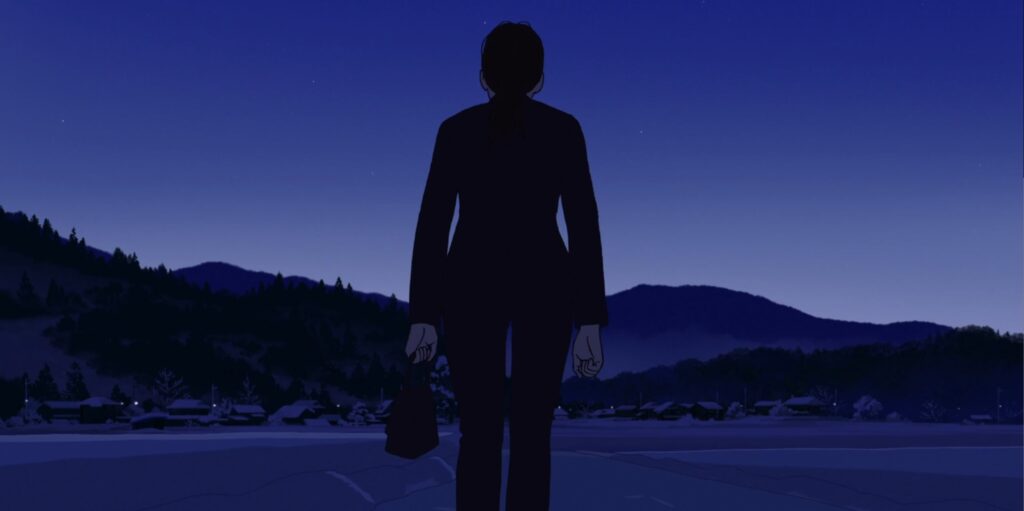
As Fujino steps away from Kyomoto’s house, the film transitions into a breathtaking winter scene that captures both the physical chill of the season and the emotional weight of the moment. The world around her is wrapped in a subdued palette of grays, whites, and muted blues, with every element of the setting reinforcing the somber tone. The snow-covered streets are quiet, undisturbed except for Fujino’s footsteps, which leave faint imprints on the frosted ground.
The lighting is masterfully executed, with the faint glow of a setting sun peeking just above the horizon, casting a soft, diffused light across the scene. The snow glistens under the fading sunlight, and the shadows of bare trees stretch long across the road, creating an almost surreal atmosphere.
The rooftops of nearby houses are layered with snow, their chimneys sending thin trails of smoke into the still air. It’s the kind of scene that makes you feel the biting cold through the screen, with every detail drawing you deeper into Fujino’s quiet reflection.
As she walks, her breath forms visible puffs in the icy air, punctuating the silence. There’s a slight breeze, evident from the gentle sway of the skeletal tree branches and the occasional scatter of loose snow from rooftops. The background fades into misty shades of white and gray, giving the scene a dreamlike quality, as if Fujino is walking through a world that mirrors her own inner turmoil.
The camera work heightens the emotional impact. A wide-angle shot shows Fujino as a small figure against the vast, empty expanse of the winter landscape, emphasizing her loneliness and the enormity of her grief. Closer shots capture the faint tremble in her steps and the weight she carries with each stride. The silence is broken only by the crunch of her footsteps and the occasional rustle of wind, further immersing the viewer in this stark, contemplative moment.
This scene is not just a transition; it’s a reflection of everything Fujino is feeling. The cold, the stillness, and the fading light all echo her sense of loss and longing. Yet, there’s also a strange beauty in it—a reminder that even in the harshest moments, the world continues, quiet and unwavering, as Fujino takes another step forward.
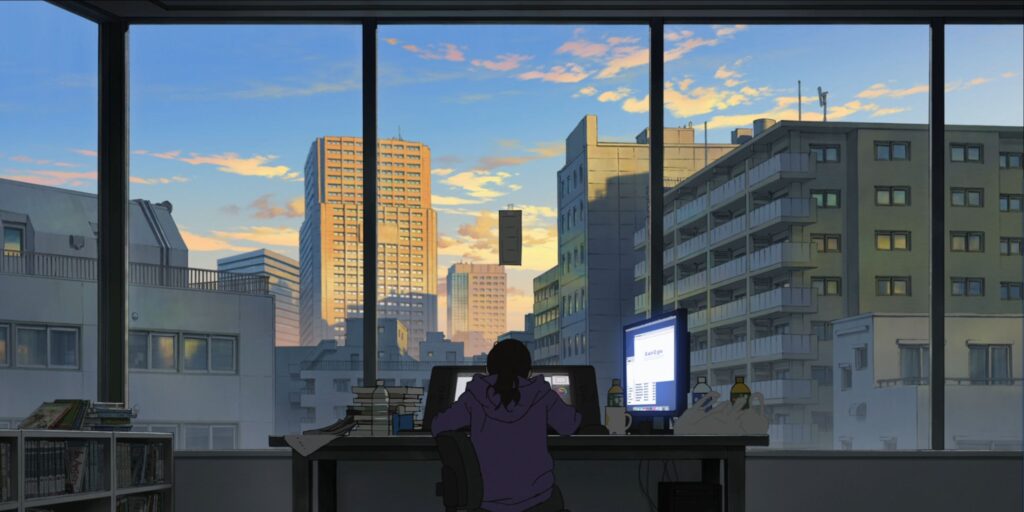
The final scene of Look Back unfolds in a serene, almost meditative tone, with Fujino sitting alone in her office. It’s a moment of quiet reflection that feels both grounded and transcendent, pulling together the emotional threads of the story. The scene opens with a panoramic shot of Fujino’s office window, showcasing an incredible cityscape bathed in the gentle hues of a rising sun.
The lighting is masterful. The soft pink and orange tones of the sunrise mix with the pale blue of the morning sky, creating a gradient of warmth and coolness that mirrors the bittersweet emotions Fujino carries. The buildings outside are in varying stages of illumination—some catching the direct light of the sun, others still shrouded in shadow. This interplay of light and darkness suggests the duality of Fujino’s journey: the weight of loss and the glimmers of hope.
Inside the office, the natural light pouring through the window contrasts with the cold, artificial glow of her computer screen. This juxtaposition feels intentional, as if to highlight the separation between Fujino’s creative passions and the sterile reality of her current life. Her desk is strewn with papers, pens, and scattered notes, remnants of her relentless dedication to her craft. Yet, the space feels lonely, devoid of the shared energy that once defined her work with Kyomoto.
The camera lingers on Fujino from behind, her figure silhouetted against the cityscape. This framing feels symbolic, inviting the audience to imagine what she’s thinking. The title of the story, Look Back, takes on a powerful resonance here. Is she looking back on her journey with Kyomoto? On the alternate timeline that might have been? Or is the film urging us, the viewers, to reflect on our own lives—the connections, the losses, and the moments that shape us?
As the scene progresses, Fujino stands and approaches the window, holding the comic strip she had earlier taped to the glass. This small action feels monumental, a quiet acknowledgment of Kyomoto’s influence and the bond they shared. The camera pulls back to an almost dreamlike wide-angle shot of the city beyond the window. It’s a breathtaking view, one that feels both hopeful and melancholic, capturing the enormity of the world outside and Fujino’s place within it.
The final moments of the film are hauntingly beautiful. The story began with Fujino at her desk, drawing as a child, and now ends with her at her desk again, this time as an adult. This cyclical structure reinforces the film’s themes of memory and growth. The viewer is left with the image of Fujino standing alone, back turned, as if inviting us to look back one last time—not just at her story, but at our own.
The ending carries a poignant ambiguity. Perhaps Kyomoto’s spirit is with her, watching over her from that unseen world. Perhaps the title Look Back serves as a reminder that the past, while painful, is always a part of us. Or perhaps it’s an invitation to embrace the memories that shape us, even as we move forward. Whatever the interpretation, the film closes with a profound stillness, leaving a lasting impression that lingers long after the credits roll.
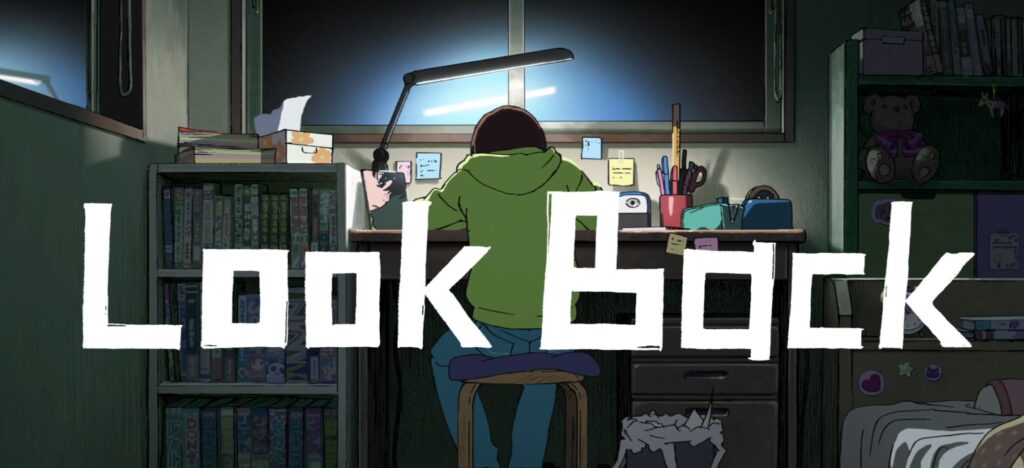
As I reflect on Look Back, I can’t help but feel a deep sense of admiration for what this film accomplished. From start to finish, it was an emotional and visual masterpiece, weaving a story that felt personal yet universally resonant. The sheer beauty of its animation—from the vibrant rural landscapes to the intricate cityscapes, and even the intimate quiet of Fujino’s office—left me utterly captivated. Every frame was crafted with such care that it felt less like watching a movie and more like stepping into a painting.
But it wasn’t just the art that stayed with me. The story, with its quiet moments of joy, heartbreak, and introspection, struck a chord that was both poignant and deeply human. Fujino and Kyomoto’s journey—a tale of creativity, friendship, and loss—was a reminder of how fleeting yet impactful our connections with others can be. It showed the highs of collaboration, the pain of absence, and the quiet strength it takes to keep moving forward.
This isn’t the kind of anime that overwhelms you with action or complex plots. It’s simple, reflective, and achingly beautiful in its restraint. That’s what made it so special for me. It didn’t try to be more than it needed to be. Instead, it embraced the power of small moments—an inspired drawing, a walk home in the rain, a glance out a frosty window—and turned them into something unforgettable.
Watching Look Back wasn’t just entertainment; it was an experience. It’s the kind of film that stays with you, sneaking into quiet moments of your day as you reflect on its message and artistry. I didn’t just enjoy Look Back; I cherished it. It’s a piece of art I’ll be thinking about for a long time, and I can’t wait to see what Studio Durian creates next.
If you’re a fan of anime or simply someone who appreciates a beautiful story, Look Back is a must-watch. It’s not loud, it’s not flashy, but it’s powerful in the way that only something made with genuine heart can be. For me, it wasn’t just a movie—it was a reminder of why I love anime and the profound stories it can tell.

Curious about what our monthly digest offers? Head over to our newsletter page to learn more, or simply sign up below to get The Stream Snob Monthly Digest with the best streaming picks, exclusive insights, and the latest trends across all major platforms, delivered straight to your inbox!
Subscribe to our newsletter!